One win separates Real Madrid from their first La Liga title since the 2016-17 season.
Villarreal stands between Real and the crown. The Yellow Submarine have ambitions of their own, entering this match with a chance to secure Europa League play next season.
When the two teams played at the Estadio de la Cerámica back in September, the home side took the lead twice, but goals from Gareth Bale rescued a draw for the visitors.
In this tactical analysis will preview the potential title-clinching game. In addition to the predicted lineups and result, this tactical preview offers an analysis of how Real Madrid will use the width of the pitch to create spaces centrally and how the side’s press resistance will lead to scoring opportunities. Finally, we’ll look at the way Villarreal will use their attacking overloads to engage in a counterpress.
Predicted lineups
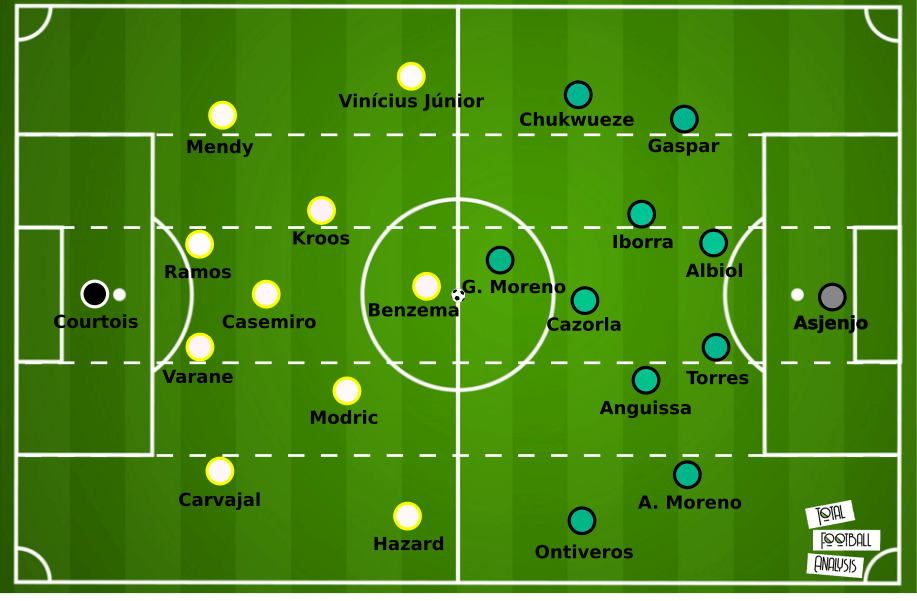
Real Madrid (4-3-3): Thibaut Courtois; Dani Carvajal, Raphaël Varane, Sergio Ramos, Ferland Mendy; Casemiro, Toni Kroos, Luka Modrić; Eden Hazard, Karim Benzema, Vinícius Júnior
For the Zinedine Zidane’s side, expect a 4-3-3. Though they lined up in a 4-4-2 in the first matchup, an additional player high up the pitch will help Madrid break the Villarreal counterpress and get to goal. Rodrygo is tipped to earn the start with Hazard, but Vinícius Júnior’s ability to win 1v1s and stretch the pitch profiles well in this match. In the midfield, Modrić offers great press resistance, making him the starter over Federico Valverde.
Villarreal (4-2-3-1): Sergio Asjenjo, Mario Gaspar, Raúl Albiol, Pau Torres, Alberto Moreno; Vincente Iborra, André-Frank Zambo Anguissa; Samuel Chukwueze, Santi Cazorla, Javier Ontiveros; Gerard Moreno
Javier Calleja’s side is likely to operate in a 4-2-3-1 in attack, then revert to a 4-4-2 as the side defends in its own half. Expect Cazorla to join G. Moreno up top, leaving Chukwueze and Ontiveros to join Iborra and Anguissa as a midfield four. At the back, look for Gaspar to make his return to the starting lineup since Rubén Peña has played a heavy dose of minutes in recent weeks.
Real Madrid must use width to open space centrally
One of the reasons I’m calling for Vinícius Júnior to start is the need to create central scoring opportunities through wide playmaking. Though Villarreal struggles to defend against crosses, stemming primarily from a poor tracking of runners into the box, don’t think the crosses will necessarily be the default in Madrid’s attack.
Studying Villarreal’s transitions through the defensive phases, the move from the middle to low block is a point of concern. Given their narrow starting positions, they do tend to gift too much time and space to the opponent’s deep playmakers. Ramos and Kroos will especially benefit from this type of approach as they have the ability to drive the ball to long-distance targets.
Once the ball reaches the high, wide targets, the Villarreal lines start to lose their structure. With the line of four midfielders dropping into deeper on the diagonal to defend against the new point of attack, they do have a tendency to lose track of their zonal responsibilities. That lack of awareness and poor pressure on the ball carrier leads to broken lines, something Real Madrid must attack in this match. As the ball enters the wings, look for Madrid to disorient the Villarreal defence, then look for quick combinations in the half spaces and central channel to produce goal-scoring opportunities.
In the example below, only Mendy and Carvajal are playing in the wings while the remaining 20 players on the pitch occupy the central channel and half spaces. Unable to play through the centre of the pitch, Kroos opted to play over the defence, into the waiting feet of Carvajal. Notice the support runs from Lucas Vázquez and Casemiro.
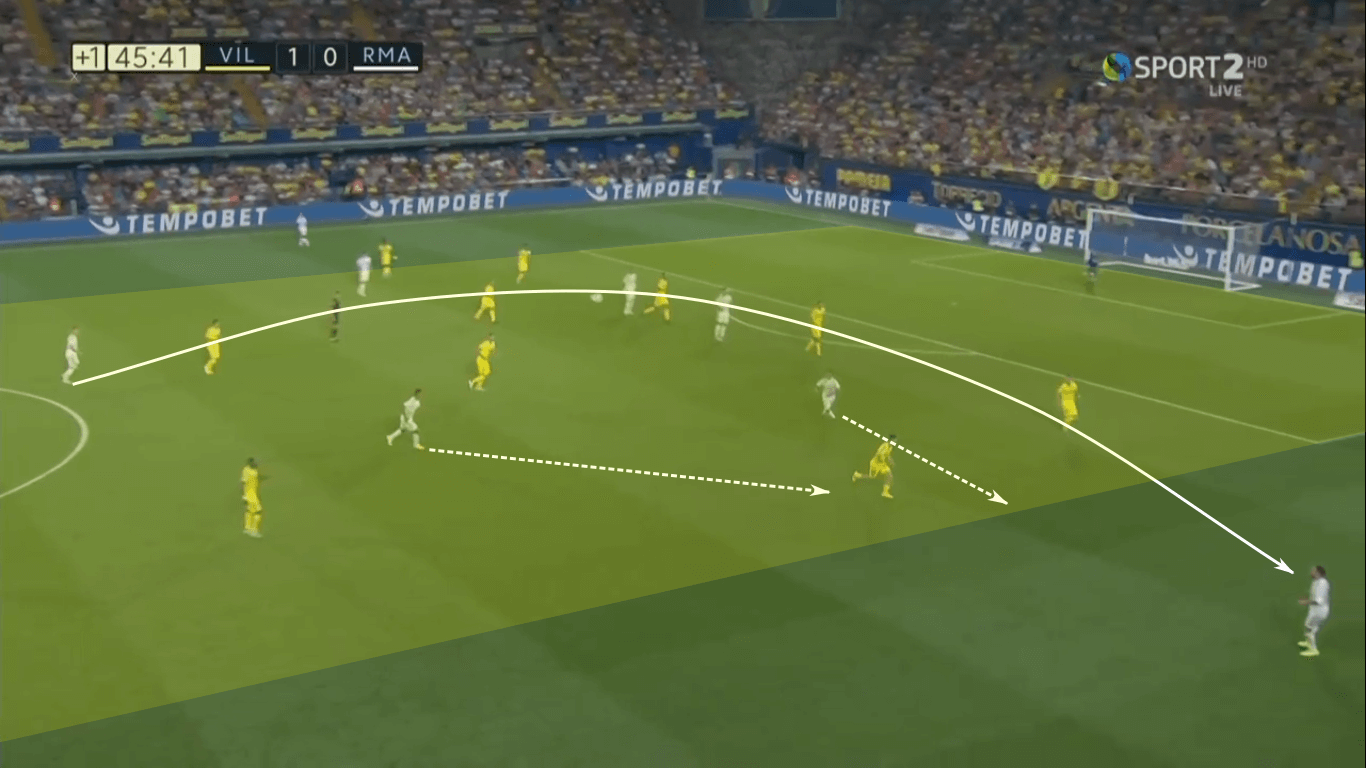
As Carvajal cuts inside, Vázquez takes the cue and underlaps his compatriot. Seeing the move to the central channel, Casemiro backs off to keep the gap open for Carvajal. In the central channel, Bale prepares to make his move.
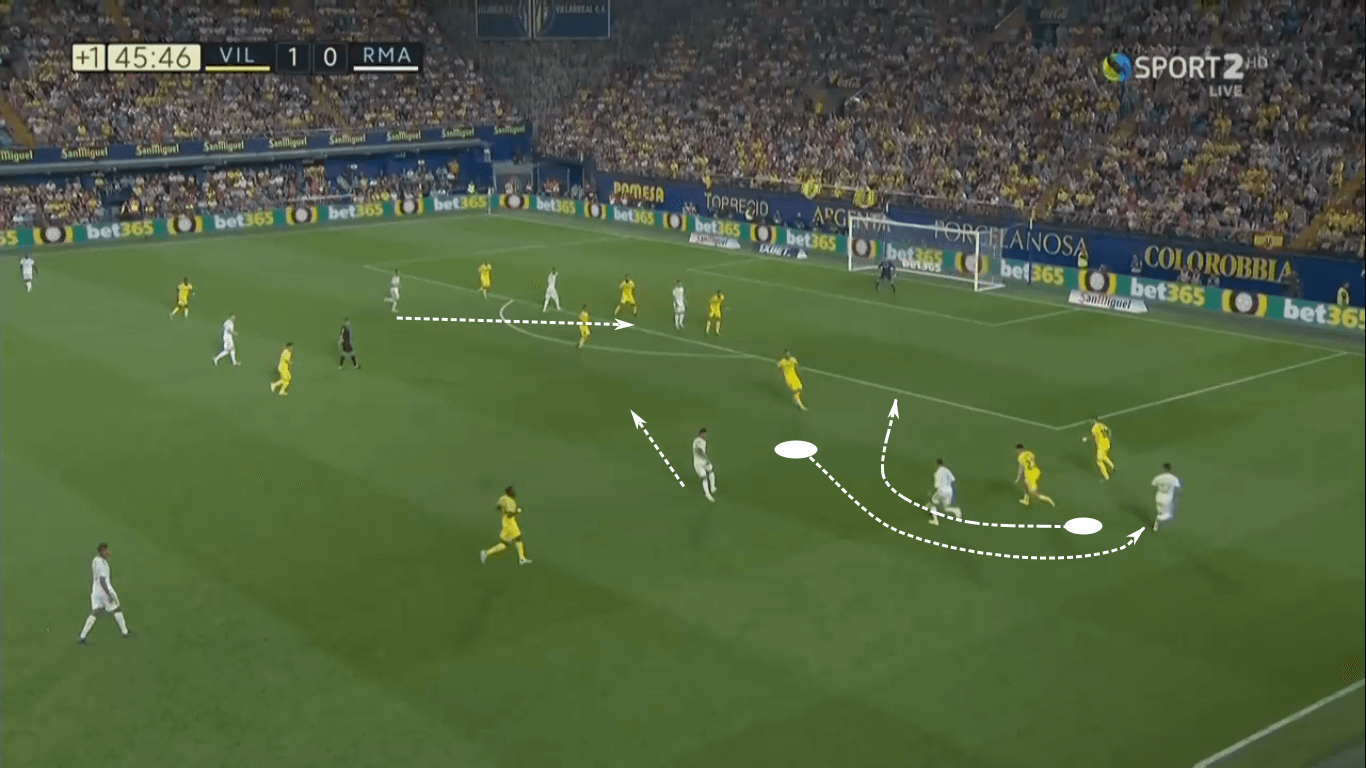
Driving towards the box, Carvajal commits the defence to his dribble, then plays negative to Casemiro, who draws the midfield towards him, then releases a pass to Benzema. The Frenchman plays Carvajal behind the lines, leaving Villarreal scrambling for solutions. At this point, the defence is so concerned with the activity near the ball, Bale is able to drift unmarked in the centre of the box.
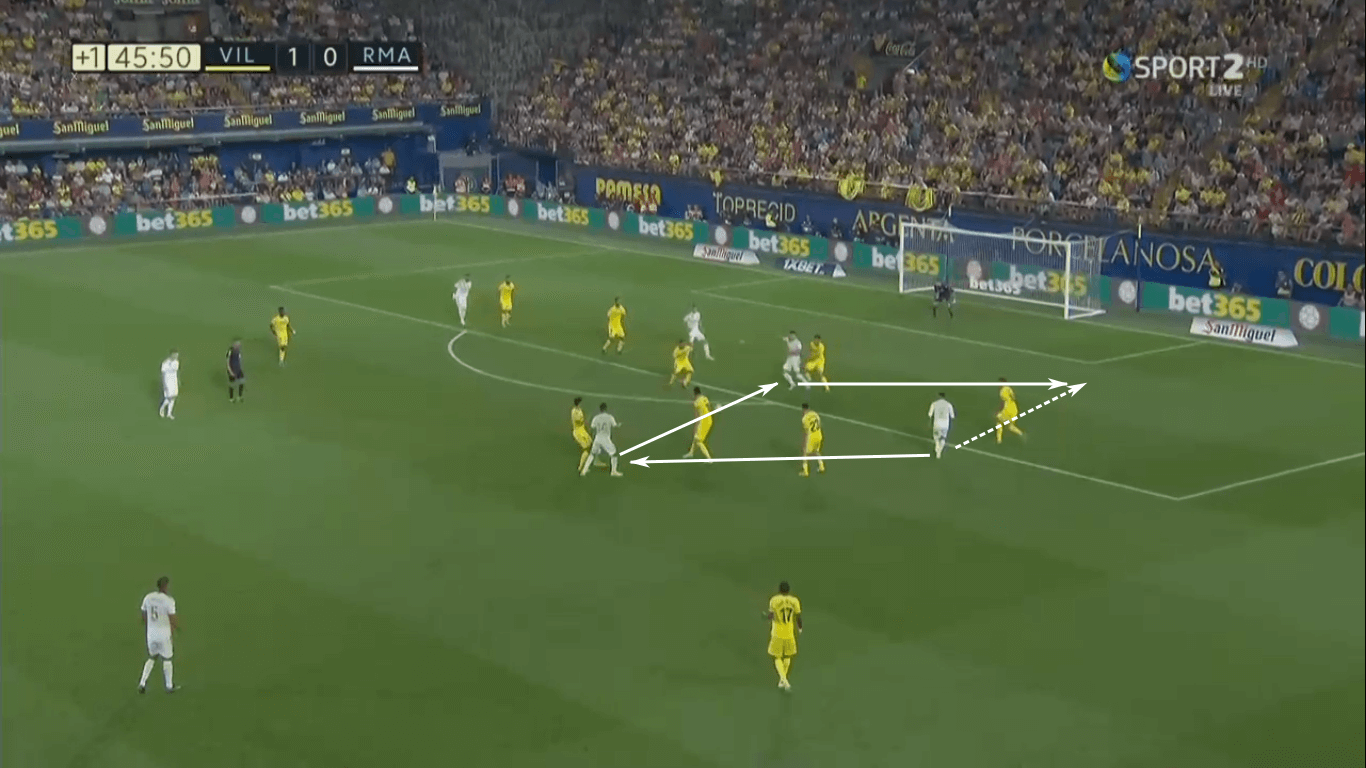
Reactive defending allows Carvajal to engage in a 1v1 with the goalkeeper, Andrés Fernández. A gentle chip to Bale is easily deposited into the back of the net, taking Real Madrid into halftime with a level scoreline.
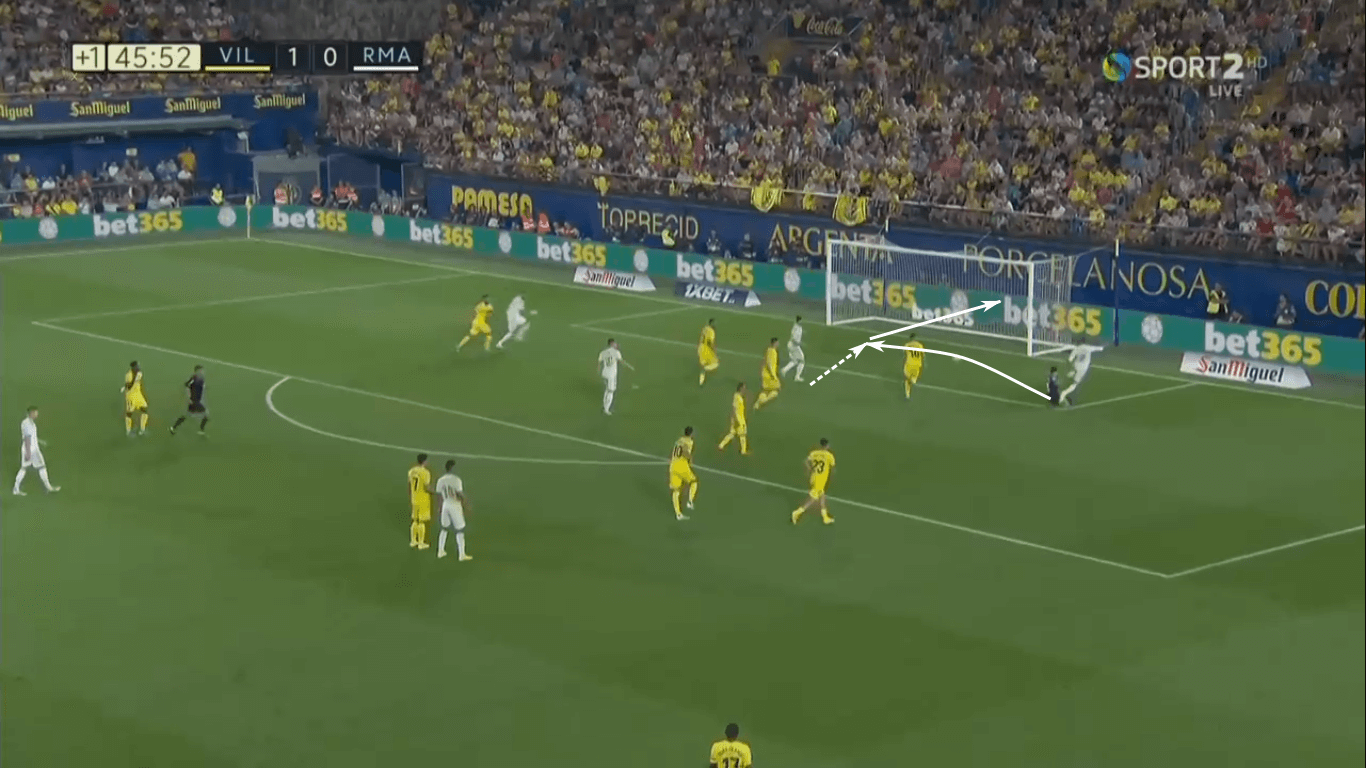
Later on, in that first matchup, we saw Benzema using his midfield drops to perfection. As Big Benz checked into the wing, Torres mistakenly followed him. That action left a massive space behind for the Frenchman to run into. A well-measured chip over the top of the defence allowed Benz to progress the ball into the Villarreal box.
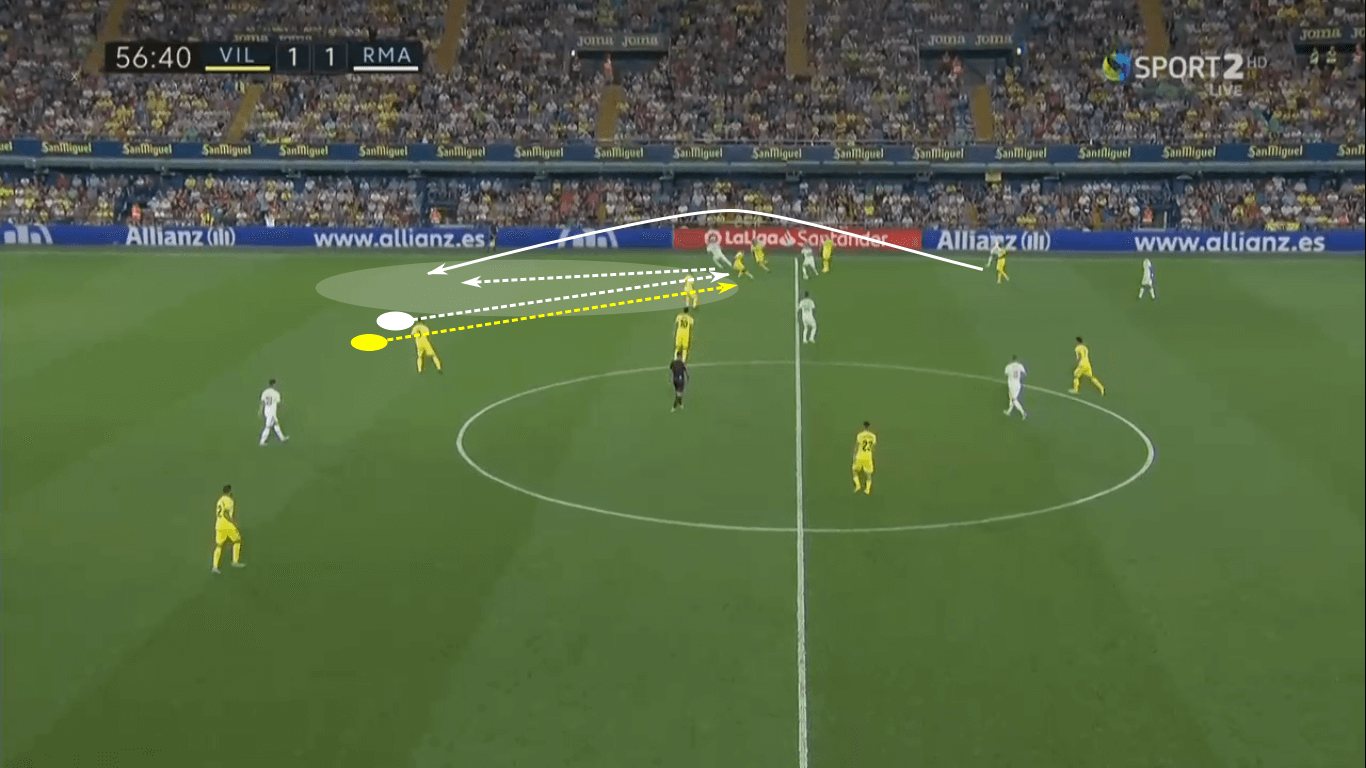
Though they didn’t score on the play, Madrid’s ability to disconnect the Villarreal backline was a key tactical component to the match. If Vinícius Júnior starts the match, look for Madrid to target him on the wings. He would likely operate in isolation, allowing him to utilise his fantastic 1v1 ability. On the other side of the pitch, expect Hazard and Benzema to work off each other. As Benzema drops into the midfield, just in front of Hazard, the Belgian will watch for the centre-backs to move with Benz. When that movement into the wings happens, look for the Hazard to dash into the available space.
Press resistance will lead to scoring opportunities
As mentioned earlier in this analysis, expect Villarreal to use a 4-2-3-1 in attack, counterpress when the ball is lost, then settle into a 4-4-2 with Cazorla pushing into the highest line. When Real Madrid lose the ball, look for the counterpress to force Villarreal backward, dangling the hope of ball retention while systematically snuffing out all intermediate and long options.
In the first match between these two clubs, the high press was utilised by both sides. In transitional moments, both teams tried to win the ball high up the pitch, but not at the expense of allowing the opponent to easily break the first line of pressure immediately upon recovery. Protecting against that immediate progression was the primary priority of the counterpress. Many times, that simply meant forcing play backward while the rest of the team recovered their shape. With the defensive shape recovered, pressure on the ball-carrier increased.
Press resistance will be key in this match, though that comes in different forms for the two sides. For Real, inviting Villarreal to engage higher up the pitch is key, but just as important is the ability to beat the press. This is why I think Modrić will start over Valverde. Although I like Valverde’s ability to receive between the lines and run at the backline, the Croatian simply offers more help in beating the first two lines of pressure.
For Villarreal, it means avoiding that retreat to goal before sending the long, central distributions. I’ll touch on this in a moment, but wing build-ups with numeric overloads offer a great chance of success.
In the image below, Real Madrid forced play backward twice, driving the Villarreal attack deep into their own half of the pitch. As the home side dropped deeper, the Real Madrid press transitioned from more of a zonal middle block to a man-to-man high press. Unable to beat the press, Villarreal forced a difficult pass into a bad area. Fortunately for them, the ball was touched wide, preventing Madrid from quickly counterattacking.
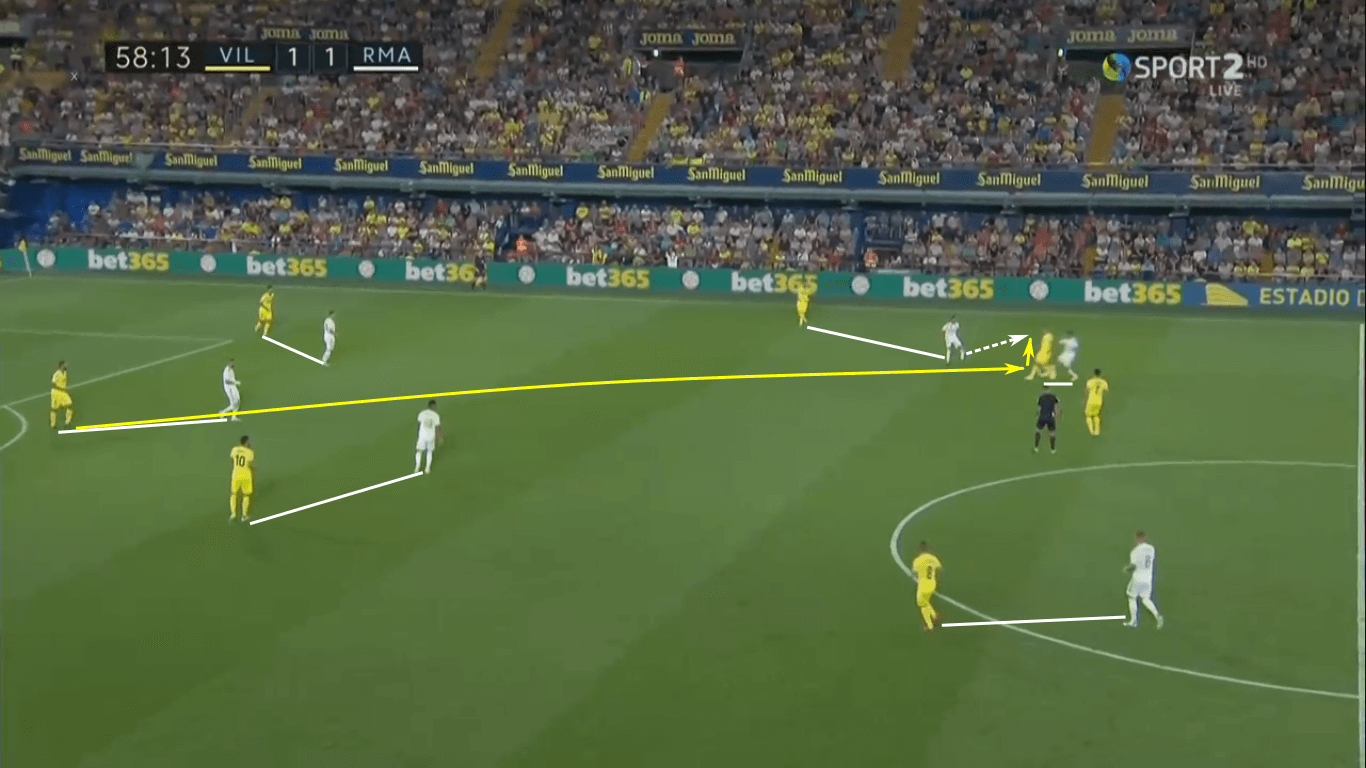
With a 0.79 xGA per game, best in La Liga, Real Madrid doesn’t concede many chances on goal. If they want to get anything out of this match, Villarreal must find a way to break the high press. Knowing that Zidane will have his team use a man-marking scheme in the high press, Calleja will likely use overloads in wide areas to help with the build-up.
Zidane’s men will try to force Villarreal to distribute from deep in the central channel. This is the first positional battle in the Villarreal build-up. If El Submarino Amarillo can break the press and establish possession in the left-wing and half space, behind the right-sided Madrid midfielder, that will pull Casemiro away from the middle of the pitch. As Casemiro moves to his right, Kroos then assumes defensive responsibility on the central channel. If Villarreal can beat the press and drag Casemiro away from the middle, their chances of creating a scoring opportunity skyrocket.
For Real Madrid, the ability to beat Villarreal’s high press could lead to a lopsided margin. As we saw in the fixture against Barcelona, Villarreal committed to pressing high up the pitch, but, in doing so, lost their defensive structure behind those first two lines. Large gaps emerged and Barcelona emerged with an easy 4-1 victory.
High pressing is part of Villarreal’s identity. Though they defend reasonably well in the middle block, issues emerge as the side concede space in the middle third to chase in the attacking third. Lose of defensive discipline is a common theme for Villarreal this season. Their 45.79 xGA (1.27 per match) for the season ranks seventh-worst in La Liga, second to Valencia among teams in the top 10 of the league.
Look for Real Madrid to pull Villarreal high up the pitch. As the side overcommits to the high press, gaps will emerge between the lines. The holding midfielders tend to maintain a better connection with the forward and attacking midfielders, offering cover for their press, so Madrid will look for ways to play through the lines, into the emerging gaps. If they can receive in space like the white circles in the image below, they can them force a decision upon the Villarreal backline.
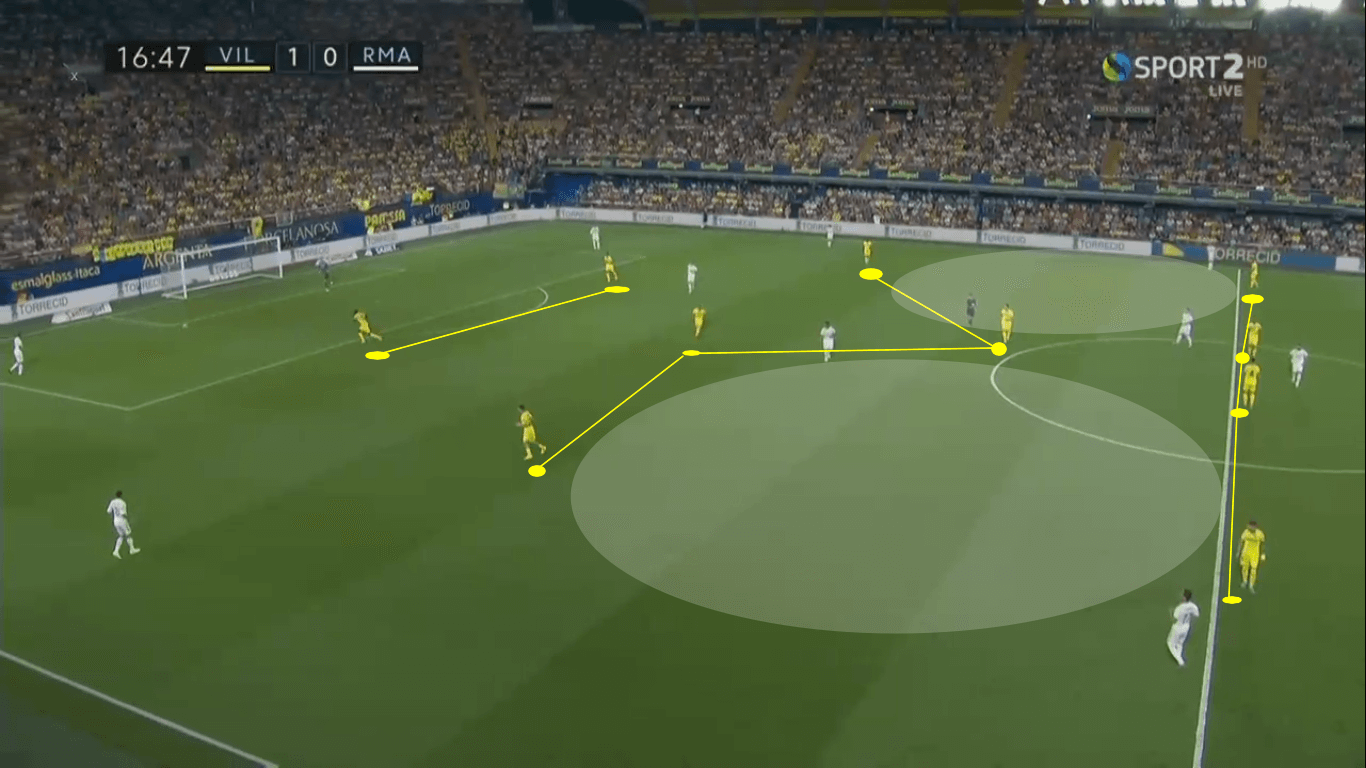
Though Villarreal’s ball-near attacking overloads are generally effective, if Real Madrid can break the counterpress, they can punish Villarreal’s poor rest defence. One reoccurring trend was the far-sided outside-back remaining deeper and more central. In the image below, Peña is positioned to help his centre-backs in the case of a counterattack. However, look at the massive amount of space the Villarreal rest defence concedes.
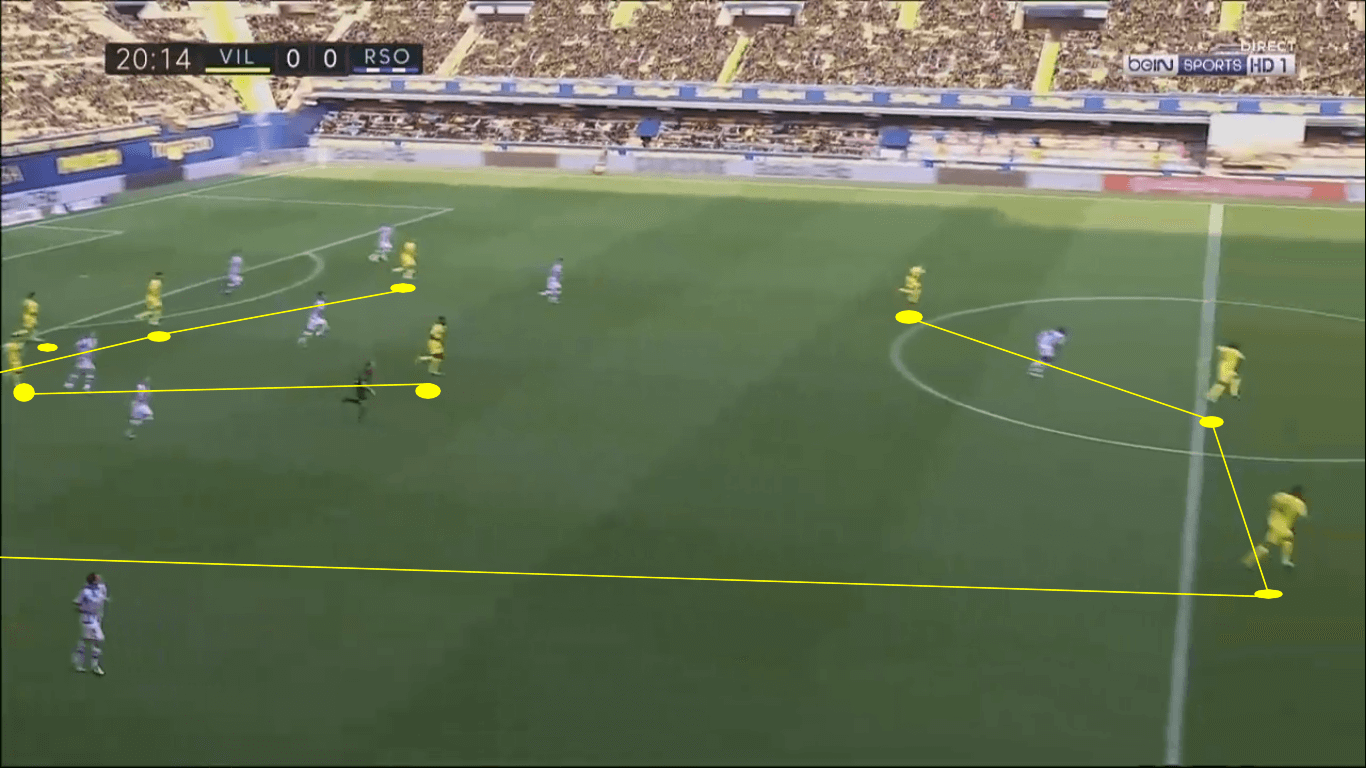
In the last match against Real Sociedad, the Villarreal high press was also unbalanced in the wings, allowing Sociedad to switch play through a central outlet.
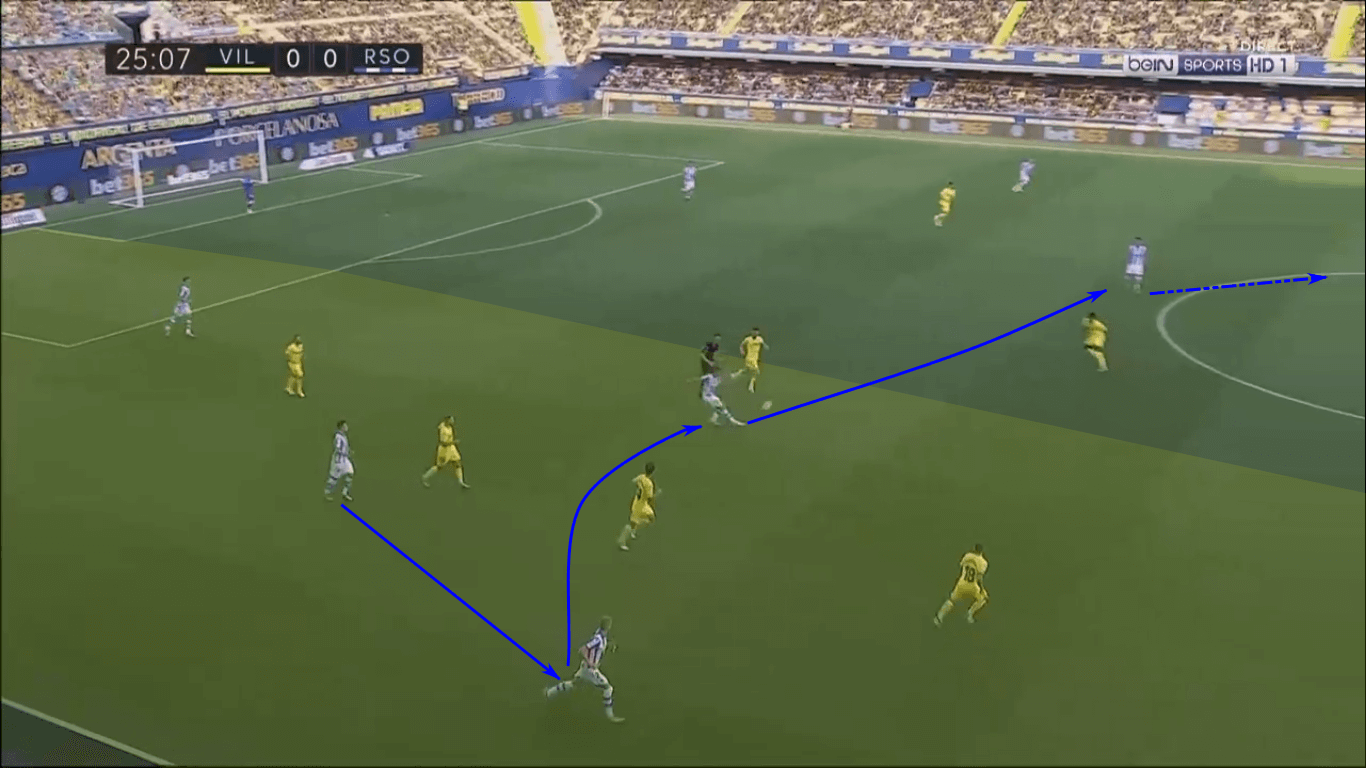
Both teams will enter the game looking to employ the high press. Resistance to that press will be key for both teams. Villarreal will find the task a difficult one, but they can greatly help their cause by avoiding being pinned centrally and distributing from deep and, as they progress higher up the pitch, moving Casemiro away from the middle of the pitch.
For Real Madrid, unbalancing the Villarreal high press and counterpress will unlock space between the holding midfielders and backline. It’s this space that they need to prioritize. If the backline and midfield can consistently beat the press, this game could get ugly, much like the Villarreal vs Barcelona match.
Villarreal’s attacking overloads and counterpress
Since we’ve just discussed Villarreal’s counterpress, this is a good time to address their attacking structure and transitional adaptability. As mentioned, this is a side that likes to take the initiative in matches, pressing high up the pitch and counterpressing to resume the attack. To ensure attacking initiative, as well as a quick recovery when the ball is lost, The Yellow Submarine look to overload near the ball when in possession.
The first benefit of the attacking overloads is that the team nearly always has a numeric superiority. As the opponent overcommits, Villarreal take advantage of an unbalanced defence. Though the far-sided outside-back starts from a deeper position, he’s always looking for the cue to push forward. Once the overload occurs, the side plays out of pressure, releasing the far-sided outside-back in the wing.
In the previous match against Real Madrid, we saw Villarreal attempt to build-up in the wings, using a numeric advantage to draw in the Madrid defence. If they can avoid the long, deep, central distributions, look for the visitors to mimic the scenario in the image below. With the numeric overload, Villarreal were better suited to break the Madrid press. When Madrid responded with more numbers, Villarreal cleverly played out of pressure.
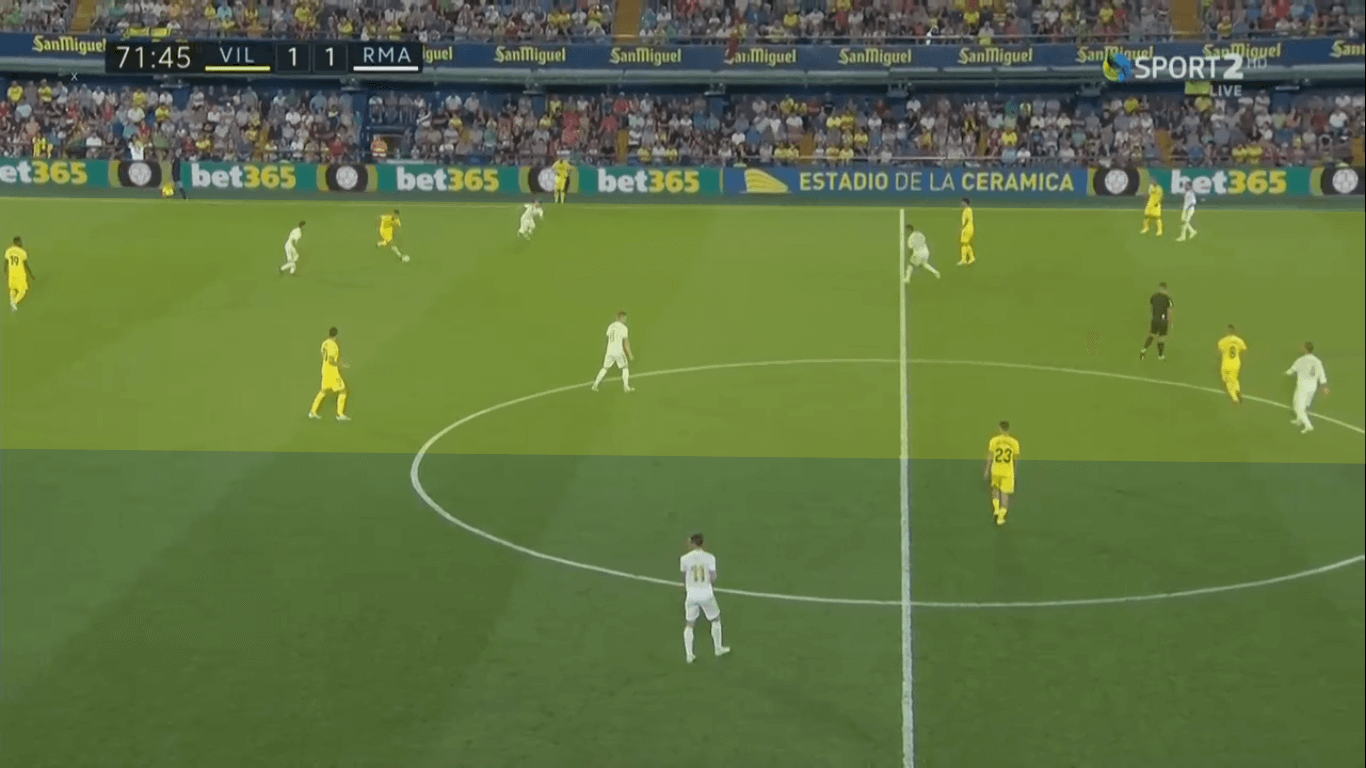
In addition to the security overloads afford possession, they also carry the benefit of a quick and easy transition to the counterpress. Since Villarreal prefer to have the initiative of play, those quick transitions are critical to denying counterattacking opportunities, especially given the amount of space this attack-heavy side leaves open. A defensive approach that mirrors the intensity and aggression of their attacking tactics sees Villarreal try to cut out the opposition’s attacks before they can properly begin.
Returning to the last match against Real Madrid, the image below shows a transitional moment deep in the Real Madrid half. Though he has able to recover the ball, Casemiro was immediately pressured by three Villarreal defenders. With no immediate outlets, the Brazilian forced the ball forward, resulting in a turnover.
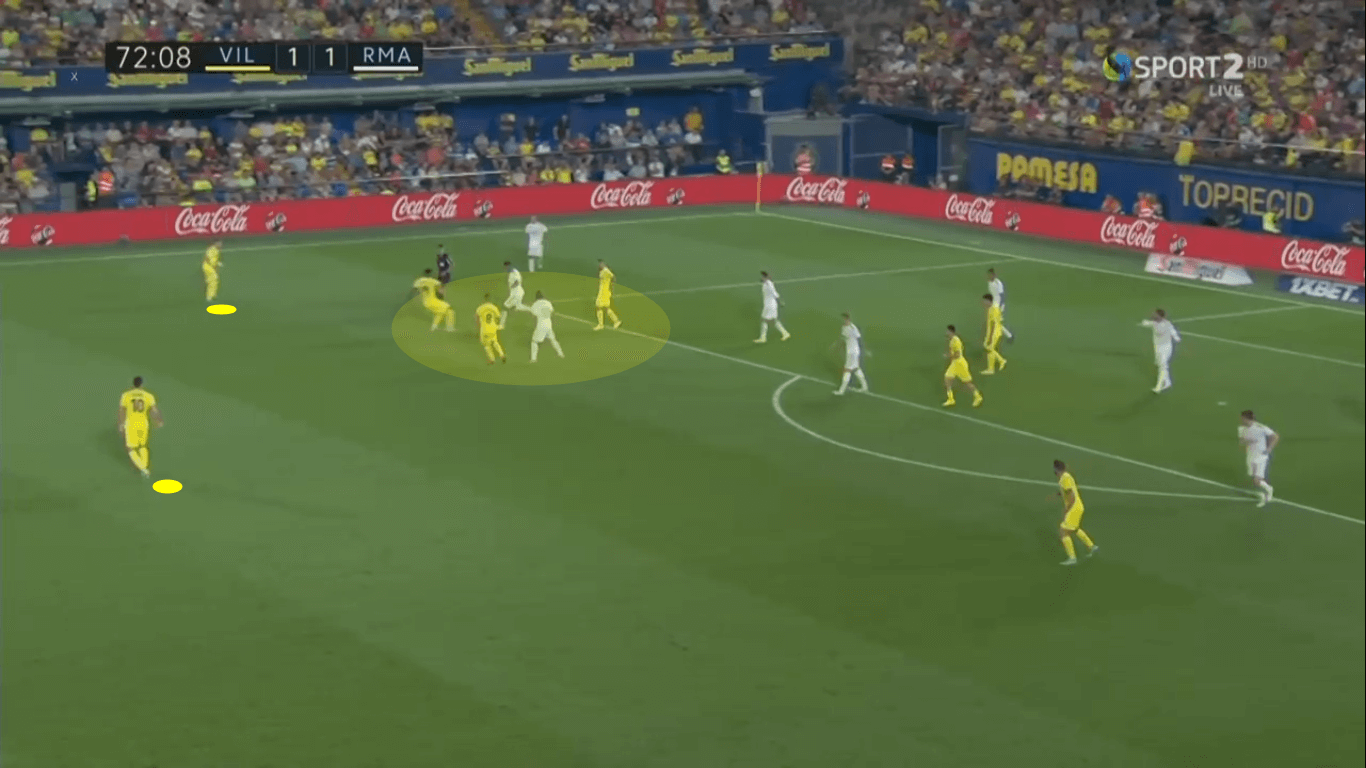
The defensive stalwart was the victim of Granada’s pressure in the previous match, leading to the home side’s goal. Though this isn’t a case of counterpressing, Granada’s recognition that the least press resistant player on Madrid’s squad led to a successful back-pressure from the forward.
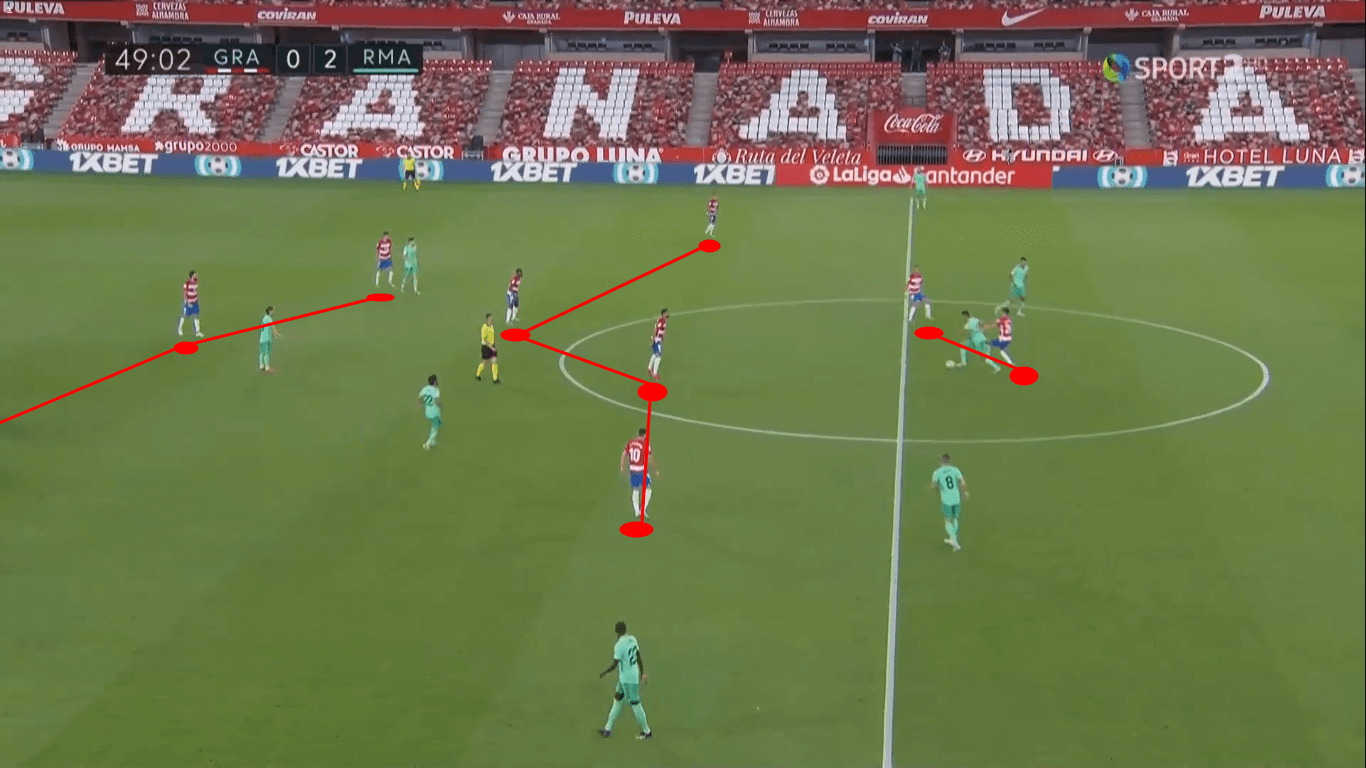
The result was a 4v3 in Granada’s favour. A well-executed counterattack gave the home side its second wind and the momentum for the remainder of the match.
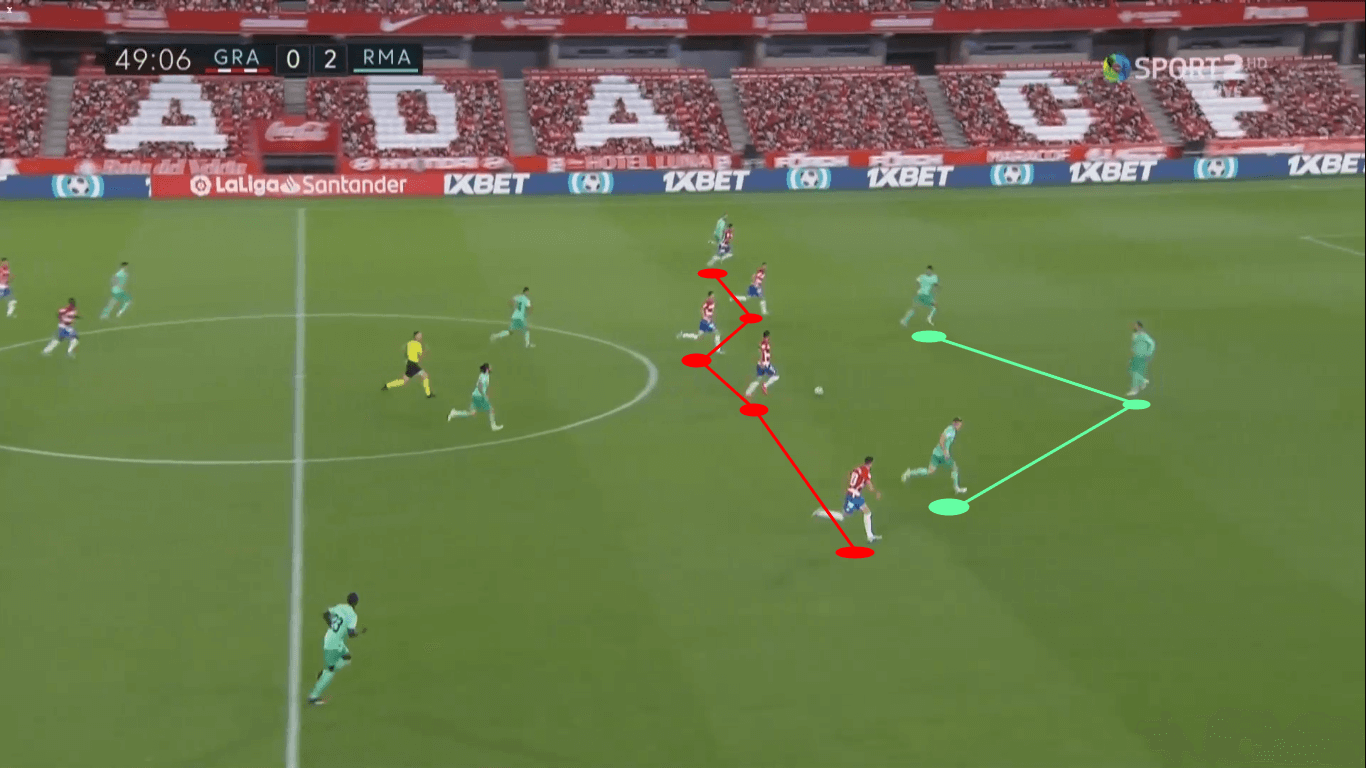
Villarreal can accomplish a similar pressing result to boost their attacking prospects. Though the counterpress is the typical means the side uses to push the attacking tempo, a reversal of priority, conceding the attacking initiative and creating attacking opportunities through defensive structures and traps, would better suit them in this match. When Madrid builds-up in their defensive third, they’re typically very reliable in possession, not expanding their attacking shape until possession is secured. Once they reach the middle third, they are generally in their preferred attacking shape. Committing pressure on the ball-carrier in this partition of the pitch, possibly targeting Casemiro, will allow that narrow Villarreal defence to transition into a narrow, more direct attack with fewer defenders to beat.
Recent matches, especially the last two, have seen Villarreal play with more attacking caution, attempting the attack while maintaining a structurally sound rest defence. That has taken a toll on their attacking play, registering a paltry 0.61 non-penalty xG. However, starting with a sound defensive approach is critical in this match. A strong middle block with pressing traps gives Villarreal’s attack the best chance of success.
Conclusion
With just one opponent standing between them and the La Liga title, Real Madrid will look to capitalize on Villarreal’s recent run of poor form. They’ll also note Villarreal’s issues defending crosses and set pieces. In the previous two matches, Villarreal has conceded three goals, all from corner kicks. Though Real Madrid has been poor with their set pieces this season, don’t be surprised if Ramos captains his side to a title with a thunderous set piece goal.
For Villarreal, this isn’t a must-win match, but they’ll certainly take any positive result they can get. The lack of attacking fluidity in recent matches is disconcerting, especially going up against the top defensive team in the league. Gauging their approach to the match is a major point of discussion. If they’ve learned from the debacle against Barcelona, you’ll see them prioritize defensive structure to set up attacking actions. That’s not in their DNA, so I certainly don’t expect to see it.
Though recent history suggests these two teams will play to a draw or one goal Real Madrid victory, I don’t see Villarreal prioritizing the defensive side of the match. Real Madrid will claim the La Liga crown with a 3-1 victory.





Comments